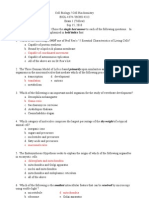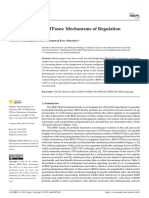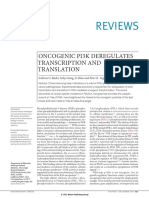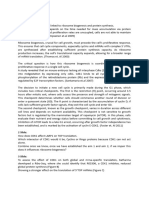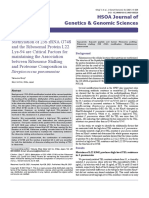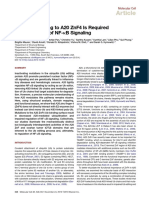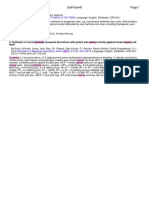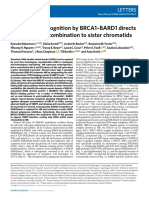Professional Documents
Culture Documents
Application of Recombinant DNATechnologies On Sub-Cloning of Transcriptional Co-Factor
Original Title
Copyright
Available Formats
Share this document
Did you find this document useful?
Is this content inappropriate?
Report this DocumentCopyright:
Available Formats
Application of Recombinant DNATechnologies On Sub-Cloning of Transcriptional Co-Factor
Copyright:
Available Formats
Volume 6, Issue 3, March – 2021 International Journal of Innovative Science and Research Technology
ISSN No:-2456-2165
Application of Recombinant DNA Technologies on
Sub-cloning of Transcriptional Co-factor
Michael Halim1
1
University of Salford, MSc Biomedical Science, Greater Manchester, United Kingdom
Corresponding author: Michael Halim
Abstract:- The expression or repression of a wide variety of necessary the transcriptional activity also has slight affection
genes, which code for protectins, controls vital physiological because of GR inhibition (Sanchez-Garcia et al., 2016).
processes like metabolism, development and immune responses. When hormone are not present then the binding of receptor
The transcription of genes started by activation of the is done by the coprocessor of GR that is NCoR (nuclear
glucocorticoid in both negative and positive manners like receptor corepressor) and SMRT (silencing mediator of
metabolism, immunization, and inflammation. The retinoid and thyroid hormone receptor). It also repress GR
transcription process is complex and involves a large number of dependent transcription by employing histone deacetylates
factors interconnected by a large number of co-factor factors. In to transcriptional complex NCoR and SMRT have CoRNR
response to stress TTC5 is an active factor because interaction boxes or LXXI/HIXXXI/L helix motifs basically they are
and stabilization and regulation of transcriptional activity of GR nuclear receptor that interacts domains. Helix motif form
depends on this co factor. There are many other factors are also different helices which binds nuclear receptors in
present but TTC5 is the main co factor because regulation of hydrophobic pocket along with C-terminal activating
GR in gene depends on it. The TTC5 control of GR is expected function domains. A major change occurs in this domain as
to contribute to glucose corticus and GR's physiological the attachment of coprocessor are inhibited by ligand
function. The TTC5 regulates the transcription of GR target binding it also controls release of nuclear receptor for
genes, including inflammation, involved in various processes. cytoplasmic complex. The interaction of co factor with GR
Duo TC5 has novel potential targets for different compounds is possible with AF1 or AF 2 domains. If it binds with AF2
which enable better control over glucocorticoid-related domain then it is called hormone dependent the members of
therapies, considering the importance of glucocorticoids in p160 family which are actually coactivators, p300/cAMP
treating inflammatory disorders and in general clinical practice. they activate against element binding protein BRG1
Wild type (2kb) is present on the agarose gel (but it is very (Brahma-related gene 1), PCAF (p300 CBP associated
blurry). Mutant type (2kb) is present on the agarose gel. factor), and vitamin receptor interacting protein 205
PET28a (5kb) is present on the agarose gel. (DRIP205)/TRAP220 (thyroid receptor associated protein
220), interact with this domain. A surface is generated by
I. INTRODUCTION hormones that has an ability of binding with LLXLL motif
they are present in coactivators after this process changes
Glucocorticoid receptor belongs to superfamily occurs in GR. The interaction between NR and coactivators
receptor that is nuclear hormone .basically glucocorticoid are possible by LXXLL motifs. On N terminus of receptor
are hormones known as lipophilic hormone adrenal cortex AF1 independent activation hormone is present. But it’s not
are the main component that releases this receptor at the restricted to the structure among NR family. The main factor
time of stress inside cytoplasm adrenal cortex are attached for the binding of AF1 has not been fully recognized yet.
with glucocorticoid in the cytoplasm . The transcription of But on the other hand members of P160 family like
genes started by activation of the glucocorticoid in both PRIP150 and tumor gene 101 are recognize as interacting
negative and positive manners like metabolism, domain (Halimah, Rahmat and Redjeki, 2019). The linked
immunization, and inflammation. In different steps like between the two domains is possible because the members
stability of protein, cofactor interaction, translational of p160 family and DRIP/TRAP complex both can interact
modification they are highly active because of different with AF-1 and AF-2 domains. The 160 family is well known
range of glucocorticoid action. During the transcriptional group which includes steroid receptor coactivator 1 (SRC-
activity the stability of glucocorticoid is really very 1), SRC-2, and SRC-3, which bind AF-2 of GR in a ligand-
important. When the exposure of GR with hormone is very dependent manner. Proteins uses intrinsic histone acetyl
long then the regulation of GR is low during proteasome transferase activity for co activation of GR. the GR can
dependent process. Protein stability has great impact at the directly bind by the employment of other cofactors that are
time of phosphorylation of receptor at the time of HATs p300/CBP (18). P300/CBP it can also act as co
proteosomal degradation of GR the key role is played by activators by acetylene histones and enrolling other HATs
ubiquitin ligases that are murine double minute w and RNA polymerase 2 to initiation point of transcription.
(Mdm2),CHIP (cterminus of hsp 70-interacting protein) and For numerous transcription factor p300 is really very
E6-AP. Other than regulation of GR proteasome machinery important p53 also includes in this family it contains
is responsible for of transcriptional activity of GR as well. transcriptional factor and serves as a component of multi
For the rearrangement of GR at promoter the proteasome is protein factor PCAF, tetratricopeptide repeat domain 5
IJISRT21MAR308 www.ijisrt.com 431
Volume 6, Issue 3, March – 2021 International Journal of Innovative Science and Research Technology
ISSN No:-2456-2165
(TTC5), and junction mediating and regulatory protein by restrictive enzymes to incorporate the desired DNA
(JMY) are includes in this factor. After phosphorylation by (Puetz and Wurm, 2019).
ataxia telangiectasia DNA is damage as a result TTC5 is
stabilized. Composition of TTC5 is depend on six protein- PHATTC5 was developed as defined and permits
protein interaction. In Yeast cell division motifs were first temporary overexpriming of TTC5 in mammalian cells
recognized and promotes anaphase complex. Motif present (Demonacos et al 2001). We cut TTC5's CDNA from this
in tandem array are made up of 34 amino acids that have plasmid using the restrictive enzymes BamH1 and Xho1 and
similarities in size, arrangement and stability (Qi et al., put it into the same-enzyme PET 28A plasmid cut, which
2015). TPR motif are involves in many functions like enables bacteria to be exposed and the overproduction of
transportation of protein. Folding of protein, degradation TTC5 is easily purified and studied, for TTC5 to become
and transcriptional regulation. Many other motif proteins are overproduced. Remember that in-frame cloning without
also involved in regulation of GR. PCR, (classical cloning technique), is required in this
strategy. If there is no feasible restriction areas, then the
II. MATERIALS AND METHODS PCR-based approach should be used (Rasala and Mayfield,
2015).
The expression or repression of a wide variety of
genes, which code for protectins, controls vital physiological Aim
processes like metabolism, development and immune The aim of this experiment was to subclone p53 and
responses. The gene transcription system, which is regulated GR transcriptional cofactor TTC5 from mammalian
by transcription factors in effect, controls various cellular expression vector into the bacterial expression vector to
processes and environmental stimulus responses. The facilitate future studies of TTC5 function
transcription process is complex and involves a large
number of factors interconnected by a large number of co- Objectives
factor factors (Chao, Yuan and Zhao, 2015). For eg, tumor Design strategy to make recombinant DNA
suppressor p53 and glucocorticoid receptor are sequence Perform restriction digestion of the DNA
defined transcription factors. To order to function Use electrophoretic techniques to separate different DNA
efficiently, these variables must communicate fragments
withTTC5/STRAP co-factor, which can be evaluated in this Isolate DNA fragments from the gel
practical manner. Demonacos et al. in 2001 described TTC5 Learn how to ligate two different pieces of DNA
as the p300 pressure sensitive activator (Demonacos, 2001; Introduce plasmid DNA into bacteria
Calderwood, 2013) as motif 5 for tetratricopeptides. The
protein of 440 amino acids was found to consist entirely of Steps
six TPR factors implicated in the development of Step 1: Set up restriction digest to transfer TTC5 cDNA
multiprotein complexes and cancer (Wen, 2018). from mammalian expression vector (HAPCDNA3) to
PET28a vector so that TTC5 can be expressed in bacteria
Plasmids Step 2: Prepared agarose gel (this will be prepared for you)
Double-stranding circular DNA molecules found in Step 3: Run the gel, cut out and isolate fragment
bacterial cells are plasmids or vectors. These can be Step 4: Ligate DNA overnight (you will prepare ligation
replicating and are used in molecular biology with multiple mix, but one will be prepared for you previous day)
copies. They have a replication origin (ori) which allows Step 5: Introduced DNA into bacteria (known as
them to replicate and produce large amounts of DNA in transformation of bacteria)
bacteria (World Health Organization, 2015). We have
antibiotic markers that can live on plates that involve this Step 1: Set up a restriction enzyme digest
antibiotic in bacteria used in selection process only. Label 3x1.5 ml eppendorf tubes (very important in order not
Furthermore, plasmids contain multiple cloning sites (MCS) to mix up your samples). Pipette DNA, buffer, water and at
which are DNA sequence clusters, which can be decreased the end add enzyme using p20 pipette according to the
scheme below.
HAPCDNA3TTC5wt(tube1) HAPCDNA3TTC5 A243G mutant (tube 2) Pet28a vector (tube 3)
DNA 14µl 14µl 14µl
Buffer 2µl 2µl 2µl
BamH1 1µl 1µl 1µl
Xho1 1µl 1µl 1µl
Water 2µl 2µl 2µl
Total 20µl 20µl 20µl
IJISRT21MAR308 www.ijisrt.com 432
Volume 6, Issue 3, March – 2021 International Journal of Innovative Science and Research Technology
ISSN No:-2456-2165
Mix the liquid and then spin briefly in the
microcentrifuge. Incubate samples for 1 hr in a 370C water Step 5: Introduce DNA into bacteria (known as
bath transformation of bacteria)
Using sterile tubes containing 50 µl DH5α E.coli from
Step 2: Prepare agarose gel (this will be done by technical Thermo Fisher Scientific chemically competent host cells.
staff for you) Key:
Agarose gel is prepared by technical staff for students W/type = 10a
M/type =10b
Step 3: Run the gel and isolate fragment pHSG298 = 10c
1. Removed the tubes from the water bath, add 5 µl of pET28a = 10d
loading buffer, mix and pulse spin
2. Removed the comb, placed the gel in electrophoresis Before plating out, labelled each LB plate
tank filled with the 1x TAE, with the wells next to appropriately with name.
negative electrode.
3. In the first lane load 10 µl of the Hyperladder 1 (DNA Thaw competent bacteria cells on ice (50 µl per
size marker) and in the rest of lanes load the entire ligation mix)
samples into respective wells. 1. Add 5 µl of the ligation mix to 50 µl of competent
4. Placed the lid on top of the tank, switched the power bacteria mix by flicking.
pack and set it to 100V. Checked if the current is 2. Place cells on ice for 1 min
flowing. After 20min stopped the electrophoresis (make 3. Heat shock in a water bath at 420C for 40 seconds
sure blue dye does not run of. 4. Place back on ice for 1 min
5. Took the gel out and placed it in the UV transiluminator 5. Add 500 µl of LB
to visualise the DNA. 6. Place on horizontal shaker for 30 min at 370C
6. Noted that only linear DNA will run in line with the 7. Plate 250 µl of each mix onto LB-kan plates
marker and therefore uncut circular plasmid size cannot 8. Allow 5 min for absorption then place plates upside
be estimated down in a 37oC incubator for 24 hrs
7. Cut out the bands: lane 2 and 3 (HAPCDNA3TTC5) 9. Next day pictures will be taken of a plate with -this will
around 2kb-this is your insert; cut out the PET28a be figure 2 in your report
plasmid band (around 5kb)-this is the plasmid you are
inserting the insert to. III. RESULTS
8. Isolate the DNA using QIAquick gel extraction kit (or if
no time purified fragments will be provided for you) Results are obtained after step 3 and step 5 respectively.
9. Weigh the excised fragment and add 3 volumes of QG
buffer Results after Step 3
10. Vortex every 2 min and incubate at 500C for 10 min to
dissolve the gel
11. Add one volume of isopropanol and mix
12. Add this to the column that is in its 2 ml tube, and spin
1min 13000 rpm
13. Discard flow through add 750 µl of PE buffer to wash
the column, spin again 1min 13000 rpm
14. Discard flow through and place the column in the clean
1.5 ml tube
15. Elute the DNA by adding 50 µl of the EB buffer and
spinning again 1min 13000 RPM
16. Use eluted DNA for ligation
Step 4: Ligate DNA
1. Label three 1.5 ml tubes and pipette into all of them 1 µl
of 10X ligation buffer, then 4 µl of distilled water into Agarose gel electrophoresis of wild type, mutant type and
the first tube and 2 µl of distilled water into tubes 2 and 3 PET28a
2. Pipette 2 µl of the cut PET28A vector into tube number 1
3. Pipette 2 µl of the cut PET28A vector and 2 µl of the Column 1: Hyperladder 1 (DNA size marker)
insert 1 (WT) into tube number 2 Column 2: Wild type
4. Pipette 2 µl of the cut PET28A vector and 2 µl of the Column 3: Mutant type
insert 1 (mut) into tube number 3 Column 4: PET28a
5. Add 1 µl of the enzyme ligase into all tubes, mix pulse
spin and incubate on the room temperature for few hours. Results interpretation: Wild type (2kb) is present on the
agarose gel (but it is very blurry). Mutant type (2kb) is
present on the agarose gel. PET28a (5kb) is present on the
agarose gel.
IJISRT21MAR308 www.ijisrt.com 433
Volume 6, Issue 3, March – 2021 International Journal of Innovative Science and Research Technology
ISSN No:-2456-2165
It is provided that the DNA is extracted from organism Lane 4 Pet only
as per the study which is being cut into small fragments of a If there are 2 bands it is possible the plasmid was not
size that will be suitable for the procedure of cloning. In cut-perhaps enzymes were not added due to pipetting error
most of the cases the cleaving the DNA is being performed or enzymes were inactivated by being left at room
to achieve this with a restriction enzyme (Jia and Jeon, temperature too long – uncut plasmid can be supercoiled
2016). Whereas different types of strains and species of DNA that can give rise to several bands o a gel
bacteria are used to extract restriction enzymes, in which
they act as defense mechanisms against viruses. Plates
No colonies can be seen if:
Results after Step 5 wrong plates-wrong antibiotic-but unlikely as there are
colonies in other plates
ligation not done properly, but positive ctrl should have
colonies transformation not done properly-pipetting
error, or competent cells left on room temperature too
long, of spreading not done properly etc.
IV. DISCUSSION
In response to stress TTC5 is an active factor because
interaction and stabilization and regulation of transcriptional
activity of GR depends on this co factor. There are many
other factors are also present but TTC5 is the main co factor
because regulation of GR in gene depends on it (Kurachi
and Kinoshita, 2019).
10A – wild type It was observed that in GR and ER ttc5 is hormone
10B – Mutant type inducible factor where as in AR it non hormone inducible
10C – PHSG298 (positive control): pUC-type bacterial factor. In GR interaction different motifs are included for
cloning vector with kanamycin resistance gene, the binding of GR the LXLLIS the most important factor
10D – cut pET28a plasmid (negative control) because modern mutation occurred in this arrangement
which can be altered later with the receptor (Withers III et
It is analyzed that staggered cuts are caused by most al., 2017). On the other hand many other motifs are also
useful restriction enzymes as they leave a single-stranded present like TRP motifs 2,3 and most important is 6 because
overhang at the site of cleavage. If the donor DNA as well most important mutation minimize in this motif. Whether
as the vector DNA are both cut with the similar enzyme. In hormone are present or not bing of GR is possible in both
addition to this it is also proven that glucocorticoid receptor possibilities buy the most activity and affinity was observed
are related to superfamily receptor which originally is a in the presence of hormone. TTC5 might be necessary as
nuclear hormone (Stehr, 2015). Basically glucocorticoid are molecular scaffold protein and can employ other cofactor
hormones which are called lipophilic hormone adrenal during transcriptional process along with numerous
cortex which are the key component releasing this receptor enzymatic activity. In protein - protein interaction TPR
in stressing conditions inside cytoplasm (Yun and Yoon, motif plays the key role and total six motif are recognized in
2017). this structure. Hsps and p300 are also associated with TTC5
and GR the most difficult structure can be easier by the
The results mentioned that wild type (2kb) is present involvement of numerous motifs in GR and TTCF
on the agarose gel. While on the other hand mutant type interaction many other substance can employ in context
(2kb) is present on the agarose gel. Moreover, it is also dependent manner (Kaddour et al., 2019). The most
identified in this report that when 2 bands are present there important factor for regulating the stability of P53 is TTCF
are chances of the fact that there is no cut on plasmid. same act is performed in GR regulation. The stability of GR
is increased by TTC5 and important role is played in
Potential explanations for different results stabilization of endogenous GR. For stabilization impact
interaction of TTC5 and GR is really very important.
Gel Because their no interaction between the TTCF mutant 1380
Lane 1 Hyperladder is used to determine molecular but able to stabilize GR when hormone is present (Marshall
weight, note depending how long the gel is run the patter et al., 2018). Our observation indicates that TTC5 protects
between provided example and your data may differ the receptor from the action of ubiquitin ligases like MDm2,
which produce in minimization proteasome mediated
Lane 2/3 no bands or smear-cause: degradation of GR. Stability of NRs and transcriptional
1. Didn’t cut the DNA factor are associated with transcriptional factor (Timm and
2. Pipetting error Niemeyer, 2015). Whenever transcription is inhibited
3. Not high enough concentration of DNA to start with or ubiquitination of Est-bound is delayed for cycling of
degraded DNA promoter degradation of ubquinated ER is very important
IJISRT21MAR308 www.ijisrt.com 434
Volume 6, Issue 3, March – 2021 International Journal of Innovative Science and Research Technology
ISSN No:-2456-2165
for efficient transcription. GR promoter cycle is also known REFERENCES
as proteasome dependent which clearly shows that
ubiquitination is also a part of transcriptional regulation. [1]. Sanchez-Garcia, L., Martín, L., Mangues, R., Ferrer-
Some of ubiquitin ligase like CHIP,Mdm2 and E6-ap are Miralles, N., Vázquez, E. and Villaverde, A., 2016.
the part of of ubiquitin pathway and it shows that the effect Recombinant pharmaceuticals from microbial cells: a
on the function of GR. P300 shows the ubiquitin ligase 2015 update. Microbial cell factories, 15(1), p.33.
performance and p53 work a substrate. Moreover many [2]. Chao, R., Yuan, Y. and Zhao, H., 2015. Recent
other substrate need to be recognized (Heather and Chain, advances in DNA assembly technologies. FEMS yeast
2016). For transcriptional performance ubiquition research, 15(1), pp.1-9.
sometimes permit factor and co factor and also variate [3]. Puetz, J. and Wurm, F.M., 2019. Recombinant
stability of GR. Transcriptional activity of GR may be Proteins for Industrial versus Pharmaceutical
affected by TTC5.variation in different factor may occurs Purposes: A Review of Process and
according to the environment and sensitivity to cycling GR. Pricing. Processes, 7(8), p.476.
For example TTC5 has great impact on transcription in [4]. Fares, F. and Azzam, N., 2019. Development of long-
genetic specific manner.by the stabilization of GR TTC5 can acting recombinant glycoprotein hormones by
trigger the transcriptional activity but it is very rare because increasing the carbohydrate content. Drug discovery
it is the only mechanism because the treatment of MG132 today.
cell increases the transcriptional activity but it is not [5]. Jia, B. and Jeon, C.O., 2016. High-throughput
possible on GR protein level. It results that that inhibition of recombinant protein expression in Escherichia coli:
the proteasome associated with the TTC5 conscription to the current status and future perspectives. Open
GILZ promoter suggests an intricate association between the biology, 6(8), p.160196.
proteasome, TTC5, and regulation of GR transcriptional [6]. Stehr, N., 2015. Knowledge politics: Governing the
activity (Heather and Chain, 2016). For the regulation of consequences of science and technology. Routledge.
transcriptional activity of GR it shows that TTC5 have to [7]. Withers III, S.T., Dominguez, M.A., Delisa, M.P. and
perform various mechanism and performance. In the Haitjema, C.H., Cornell University and Wisconsin
regulation of GR the major function of TTC5 is controlled Alumni Research Foundation, 2017. Systems and
by stress. The activity and performance of numerous post methods for the secretion of recombinant proteins in
transitionally modified version of TTC5, which could vary gram negative bacteria. U.S. Patent 9,574,197.
structure, habitation, arrangement and surface for the [8]. Marshall, R., Maxwell, C.S., Collins, S.P., Jacobsen,
attachment of GR or other cofactor or TTC5 protein levels. T., Luo, M.L., Begemann, M.B., Gray, B.N., January,
That is the reason, different stress other than hormone could E., Singer, A., He, Y. and Beisel, C.L., 2018. Rapid
command the cellular response to glucocorticoids during and scalable characterization of CRISPR technologies
stress condition. The transcriptional activity of GR is using an E. coli cell-free transcription-translation
regulated by employing the multiple mechanisms by the system. Molecular cell, 69(1), pp.146-157.
TTC5. [9]. Heather, J.M. and Chain, B., 2016. The sequence of
sequencers: The history of sequencing
TTC5's function in GR control seems to be motivated DNA. Genomics, 107(1), pp.1-8.
by stress. Stress. This could represent the results of [10]. Skraly, F.A. and Li, N., JOULE UNILIMITED
translationally altered TTC5 variants, which could affect the TECHNOLOGIES, INC., 2016. Recombinant
transcription, composition, binding sites accessible for GR synthesis of medium chain-length alkanes. U.S. Patent
or other GR or protein levels of TTC5. Consequently, the 9,528,127.
cellular reaction to glucocorticoids can primarily be [11]. Omidfar, K. and Daneshpour, M., 2015. Advances in
calculated under stressful conditions by cortisol rather than phage display technology for drug discovery. Expert
hormone (Skraly and Li, 2016). The TTC5 control of GR is opinion on drug discovery, 10(6), pp.651-669.
expected to contribute to glucose corticus and GR's [12]. Timm, C. and Niemeyer, C.M., 2015. Assembly and
physiological function. The TTC5 regulates the transcription purification of enzyme‐functionalized DNA origami
of GR target genes, including inflammation, involved in structures. Angewandte Chemie International
various processes. Duo TC5 has novel potential targets for Edition, 54(23), pp.6745-6750.
different compounds which enable better control over [13]. Kaddour, N., Zhang, D., Gao, Z.H. and Liu, J.L., 2019.
glucocorticoid-related therapies, considering the importance Recombinant protein CCN5/WISP2 promotes islet cell
of glucocorticoids in treating inflammatory disorders and in proliferation and survival in vitro. Growth Factors,
general clinical practice (Omidfar and Daneshpour, 2015). pp.1-11.
[14]. Kurachi, K. and Kinoshita, M., SPIBER Inc,
2019. Method for Producing Recombinant Protein.
U.S. Patent Application 16/322,518.
IJISRT21MAR308 www.ijisrt.com 435
Volume 6, Issue 3, March – 2021 International Journal of Innovative Science and Research Technology
ISSN No:-2456-2165
[15]. Yun, C.O. and Yoon, A.R., GENEMEDICINE CO.,
LTD., 2017. Gene delivery system having enhanced
tumor-specific expression, and recombinant gene
expression regulating sequence. U.S. Patent 9,689,000.
[16]. Rasala, B.A. and Mayfield, S.P., 2015. Photosynthetic
biomanufacturing in green algae; production of
recombinant proteins for industrial, nutritional, and
medical uses. Photosynthesis research, 123(3), pp.227-
239.
[17]. World Health Organization, 2015. Report of the
seventh meeting with international partners on
prospects for influenza vaccine technology transfer to
developing country vaccine manufacturers, Dubai,
United Arab Emirates, 25-26 March 2014. World
Health Organization.
[18]. Wen, J., Vivibaba Inc, 2018. Compositions and
methods for recombinant nerve growth factor. U.S.
Patent Application 15/892,527.
[19]. Qi, W.W., Yu, H.Y., Guo, H., Lou, J., Wang, Z.M.,
Liu, P., Sapin-Minet, A., Maincent, P., Hong, X.C.,
Hu, X.M. and Xiao, Y.L., 2015. Doxorubicin-loaded
glycyrrhetinic acid modified recombinant human
serum albumin nanoparticles for targeting liver tumor
chemotherapy. Molecular pharmaceutics, 12(3),
pp.675-683.
[20]. Halimah, M., Rahmat, A. and Redjeki, S., 2019, July.
Use of video modeling examples to improve
understanding of the concept of recombinant DNA
technology for biology teacher candidates. In AIP
Conference Proceedings (Vol. 2120, No. 1, p.
060014). AIP Publishing.
IJISRT21MAR308 www.ijisrt.com 436
You might also like
- Encyclopedia of Biological Chemistry - Vol - 3Document848 pagesEncyclopedia of Biological Chemistry - Vol - 3joshigauta100% (1)
- Alzheimer Disease Sourcebook 5th Ed. - A. Sutton (Omnigraphics, 2011) BBSDocument335 pagesAlzheimer Disease Sourcebook 5th Ed. - A. Sutton (Omnigraphics, 2011) BBSvkarmoNo ratings yet
- Regulation of the Cell Cycle by Protein KinasesDocument5 pagesRegulation of the Cell Cycle by Protein KinasesmohsinNo ratings yet
- Bruce Alberts Science, 1 April 2011 Vol 332, Issue 6025, 332 6025 332 2011Document116 pagesBruce Alberts Science, 1 April 2011 Vol 332, Issue 6025, 332 6025 332 2011José CardozoNo ratings yet
- Test Bank For Molecular Biology of The Cell 5th Edition Bruce AlbertsDocument9 pagesTest Bank For Molecular Biology of The Cell 5th Edition Bruce AlbertsJustinReidmajof100% (28)
- Pencernaan Protein Dan Penyerapan Asam AminoDocument33 pagesPencernaan Protein Dan Penyerapan Asam AminoAnonymous DVg2tmBINo ratings yet
- Cell Biology Exam 1 ReaDocument7 pagesCell Biology Exam 1 ReaCsa At Uh100% (3)
- Cellular and Molecular Mechanisms of Inflammation: Receptors of Inflammatory Cells: Structure—Function RelationshipsFrom EverandCellular and Molecular Mechanisms of Inflammation: Receptors of Inflammatory Cells: Structure—Function RelationshipsCharles G. CochraneNo ratings yet
- HHMI - The p53 Gene and CancerDocument4 pagesHHMI - The p53 Gene and CancerThe vegetal saiyanNo ratings yet
- tmpEE76 TMPDocument16 pagestmpEE76 TMPFrontiersNo ratings yet
- Oncogenic PI3K Nature Reviews CancerDocument9 pagesOncogenic PI3K Nature Reviews CancerSava1988No ratings yet
- A Chloroplast Envelope-Bound PHD Transcription Factor Mediates Chloroplast Signals To The Nucleus.Document10 pagesA Chloroplast Envelope-Bound PHD Transcription Factor Mediates Chloroplast Signals To The Nucleus.pyu2No ratings yet
- Review Article: The metabolic modulator PGC-1α in cancerDocument14 pagesReview Article: The metabolic modulator PGC-1α in cancerAlIsh BhanDariNo ratings yet
- New Insights Into The Functions of Intersectin-1s: Sanda Predescu, Cristina Bardita, and Dan PredescuDocument3 pagesNew Insights Into The Functions of Intersectin-1s: Sanda Predescu, Cristina Bardita, and Dan PredescuSergeat18BNo ratings yet
- Field 等 - 2020 - Mitochondrial Integrity Regulated by Lipid MetabolDocument32 pagesField 等 - 2020 - Mitochondrial Integrity Regulated by Lipid MetabolliqinggreenNo ratings yet
- tmp3AAA TMPDocument10 pagestmp3AAA TMPFrontiersNo ratings yet
- 1997-Oncoprotein NetworksDocument14 pages1997-Oncoprotein NetworksyicinenNo ratings yet
- Gene Ontology PDFDocument11 pagesGene Ontology PDFAnonymous w4ufne6WgNo ratings yet
- Frontiers in BiologyDocument14 pagesFrontiers in BiologyAkademisyen BirisiNo ratings yet
- Research ProposalDocument7 pagesResearch ProposalBitan BiswasNo ratings yet
- p53 (Tumor Suppressor Gene) : Presented By: Saeed Rashid Presented To: Sir YasirDocument25 pagesp53 (Tumor Suppressor Gene) : Presented By: Saeed Rashid Presented To: Sir YasirSaeed RashidNo ratings yet
- MED14 and MED1 Differentially Regulate TargetSpecific Gene Activation by The GlucocorticoidDocument13 pagesMED14 and MED1 Differentially Regulate TargetSpecific Gene Activation by The GlucocorticoidSyifa SariNo ratings yet
- GSEA ChromatinDocument17 pagesGSEA ChromatinEduardo ArredondoNo ratings yet
- Adcock Pulmonary Pharmacology & Therapeutics 2000Document9 pagesAdcock Pulmonary Pharmacology & Therapeutics 2000vnq6gd6qbxNo ratings yet
- Marking Time: The Dynamic Role of Chromatin and Covalent Modification in TranscriptionDocument6 pagesMarking Time: The Dynamic Role of Chromatin and Covalent Modification in TranscriptionNeisseria GonorrhoeaeNo ratings yet
- 316 Report DraftDocument53 pages316 Report DraftSimon TsoiNo ratings yet
- Cellular Factors for HIV-1 TranscriptionDocument7 pagesCellular Factors for HIV-1 TranscriptionDevi OktafianiNo ratings yet
- Tendons and RehabDocument1 pageTendons and Rehablucas o'brienNo ratings yet
- Epigenetic Regulation of Cancer-Associated Gene ProductsDocument27 pagesEpigenetic Regulation of Cancer-Associated Gene ProductsPace RaditNo ratings yet
- Cells 10 01831 v2Document24 pagesCells 10 01831 v2msiddique13216No ratings yet
- My Journal 2Document11 pagesMy Journal 2FelixNo ratings yet
- 1 s2.0 S0968000414002205 MainDocument13 pages1 s2.0 S0968000414002205 MaingordonmosheNo ratings yet
- Genomic and Non-Genomic Effects of Glucocorticoids in Breast CancerDocument10 pagesGenomic and Non-Genomic Effects of Glucocorticoids in Breast CancerCarlos BerumenNo ratings yet
- Regulation of Innate Immune Functions by Guanylate-Binding ProteinsDocument9 pagesRegulation of Innate Immune Functions by Guanylate-Binding ProteinsRadwan AlzidanNo ratings yet
- Plakat EMBO 2011Document1 pagePlakat EMBO 2011Magdalena PruszkoNo ratings yet
- Presentacion BogotaDocument4 pagesPresentacion BogotaMICKAELA TERNET OBANDONo ratings yet
- H3K4me3 Main PDFDocument16 pagesH3K4me3 Main PDFAsterasNo ratings yet
- Fimmu 03 00130Document18 pagesFimmu 03 00130Isabella1237No ratings yet
- Tgf-Health and Disease: Action in The Cartilage inDocument21 pagesTgf-Health and Disease: Action in The Cartilage inResa PutraNo ratings yet
- The Therapeutic Age of The Neonatal FC Receptor: ImmunologyDocument18 pagesThe Therapeutic Age of The Neonatal FC Receptor: ImmunologyonlydarkheartNo ratings yet
- Reviews: Oncogenic Pi3K Deregulates Transcription and TranslationDocument9 pagesReviews: Oncogenic Pi3K Deregulates Transcription and Translationmilenerato2240No ratings yet
- GPCR refDocument15 pagesGPCR refMarry FCCNo ratings yet
- CMAR 35175 The Orphan G Protein Receptor Gpr55 As An Emerging Target in 062813Document9 pagesCMAR 35175 The Orphan G Protein Receptor Gpr55 As An Emerging Target in 062813umesh123patilNo ratings yet
- Meu Resumo para ApresentacaoDocument7 pagesMeu Resumo para ApresentacaoSara SantosNo ratings yet
- Bansal Et Al, 2022Document21 pagesBansal Et Al, 2022Akanksha BansalNo ratings yet
- (17417899 - Reproduction) Regulation of Gene Transcription in The EpididymisDocument8 pages(17417899 - Reproduction) Regulation of Gene Transcription in The EpididymisAhmad SolihinNo ratings yet
- Chaperonas Moleculares PDFDocument11 pagesChaperonas Moleculares PDFMARIBELNo ratings yet
- 24-Journal of Cancer Research and Clinical Oncology - 2020 - PaccosiDocument11 pages24-Journal of Cancer Research and Clinical Oncology - 2020 - PaccosiSara PaccosiNo ratings yet
- p38 Mitogen-Activated Protein Kinase Is The Central Regulator of Cyclic AMP-Dependent Transcription of The Brown Fat Uncoupling Protein 1 GeneDocument11 pagesp38 Mitogen-Activated Protein Kinase Is The Central Regulator of Cyclic AMP-Dependent Transcription of The Brown Fat Uncoupling Protein 1 GeneAlmir FilsNo ratings yet
- RNA Interference in J774 Macrophages Reveals A Role For Coronin 1 in Mycobacterial Trafficking But Not in Actin-Dependent ProcessesDocument11 pagesRNA Interference in J774 Macrophages Reveals A Role For Coronin 1 in Mycobacterial Trafficking But Not in Actin-Dependent ProcessesAbdulaziz AlharbiNo ratings yet
- GADD45B Growth Arrest and DNA-damage-inducible, BetaDocument6 pagesGADD45B Growth Arrest and DNA-damage-inducible, BetaHassan Ahmed HassanNo ratings yet
- Interaction of Glucocorticoid Receptor Isoforms With TranscriptionDocument10 pagesInteraction of Glucocorticoid Receptor Isoforms With TranscriptionSyifa SariNo ratings yet
- Protein Kinase PfCLK3Document4 pagesProtein Kinase PfCLK3Ilva Kristiāna LangrateNo ratings yet
- 1649 FullDocument12 pages1649 FullJuan Pablo PérezNo ratings yet
- Emerging Issues in Receptor Protein Tyrosine Phosphatase Function: Lifting Fog or Simply Shifting?Document11 pagesEmerging Issues in Receptor Protein Tyrosine Phosphatase Function: Lifting Fog or Simply Shifting?LUCAS GONÇALVES DE OLIVEIRANo ratings yet
- Wright 2015Document12 pagesWright 2015LasaroNo ratings yet
- MCB00436-22-Merged - PDF MergedDocument47 pagesMCB00436-22-Merged - PDF MergedHector Ivan Saldivar CeronNo ratings yet
- TMP DF16Document6 pagesTMP DF16FrontiersNo ratings yet
- Molecular Biology of Pharmacology and GeneticsDocument39 pagesMolecular Biology of Pharmacology and GeneticsSusi RutmalemNo ratings yet
- Transduction Protein Interactions Define Specificity in Signal ProteinDocument22 pagesTransduction Protein Interactions Define Specificity in Signal ProteinnitishpathaniaNo ratings yet
- G-tract element mediates apoptotic agents-induced alternative splicingDocument12 pagesG-tract element mediates apoptotic agents-induced alternative splicingcrosswordxNo ratings yet
- Thyroid CA Therapeutic TargetDocument12 pagesThyroid CA Therapeutic TargetJoni MokodoNo ratings yet
- 35IJEAB 102202112 EffectofDocument8 pages35IJEAB 102202112 EffectofIJEAB JournalNo ratings yet
- Roles of PTBP1 in Alternative Splicing, Glycolysis, and OncogensisDocument15 pagesRoles of PTBP1 in Alternative Splicing, Glycolysis, and OncogensisAamir SohailNo ratings yet
- mTOR & PI3K/Akt Signaling Pathways Interactive GuideDocument6 pagesmTOR & PI3K/Akt Signaling Pathways Interactive GuideKiki GirindraNo ratings yet
- Molecular BiologyDocument44 pagesMolecular BiologyYasmin BalochNo ratings yet
- PI3K/Akt signaling pathway regulates erythropoiesis and glycolysis in hypoxiaDocument9 pagesPI3K/Akt signaling pathway regulates erythropoiesis and glycolysis in hypoxiapasifikaNo ratings yet
- Methylation of 23s Rrna g748 and The Ribosomal Protein l22 Lys 94 Are Critical Factors For Maintaining The Association Between Ribosome Stalling and Proteome Composition in Streptococcus PneumoniaeDocument8 pagesMethylation of 23s Rrna g748 and The Ribosomal Protein l22 Lys 94 Are Critical Factors For Maintaining The Association Between Ribosome Stalling and Proteome Composition in Streptococcus PneumoniaeHerald Scholarly Open AccessNo ratings yet
- Comparatively Design and Analyze Elevated Rectangular Water Reservoir with and without Bracing for Different Stagging HeightDocument4 pagesComparatively Design and Analyze Elevated Rectangular Water Reservoir with and without Bracing for Different Stagging HeightInternational Journal of Innovative Science and Research TechnologyNo ratings yet
- Diabetic Retinopathy Stage Detection Using CNN and Inception V3Document9 pagesDiabetic Retinopathy Stage Detection Using CNN and Inception V3International Journal of Innovative Science and Research TechnologyNo ratings yet
- The Utilization of Date Palm (Phoenix dactylifera) Leaf Fiber as a Main Component in Making an Improvised Water FilterDocument11 pagesThe Utilization of Date Palm (Phoenix dactylifera) Leaf Fiber as a Main Component in Making an Improvised Water FilterInternational Journal of Innovative Science and Research TechnologyNo ratings yet
- Advancing Healthcare Predictions: Harnessing Machine Learning for Accurate Health Index PrognosisDocument8 pagesAdvancing Healthcare Predictions: Harnessing Machine Learning for Accurate Health Index PrognosisInternational Journal of Innovative Science and Research TechnologyNo ratings yet
- Dense Wavelength Division Multiplexing (DWDM) in IT Networks: A Leap Beyond Synchronous Digital Hierarchy (SDH)Document2 pagesDense Wavelength Division Multiplexing (DWDM) in IT Networks: A Leap Beyond Synchronous Digital Hierarchy (SDH)International Journal of Innovative Science and Research TechnologyNo ratings yet
- Electro-Optics Properties of Intact Cocoa Beans based on Near Infrared TechnologyDocument7 pagesElectro-Optics Properties of Intact Cocoa Beans based on Near Infrared TechnologyInternational Journal of Innovative Science and Research TechnologyNo ratings yet
- Formulation and Evaluation of Poly Herbal Body ScrubDocument6 pagesFormulation and Evaluation of Poly Herbal Body ScrubInternational Journal of Innovative Science and Research TechnologyNo ratings yet
- Terracing as an Old-Style Scheme of Soil Water Preservation in Djingliya-Mandara Mountains- CameroonDocument14 pagesTerracing as an Old-Style Scheme of Soil Water Preservation in Djingliya-Mandara Mountains- CameroonInternational Journal of Innovative Science and Research TechnologyNo ratings yet
- The Impact of Digital Marketing Dimensions on Customer SatisfactionDocument6 pagesThe Impact of Digital Marketing Dimensions on Customer SatisfactionInternational Journal of Innovative Science and Research TechnologyNo ratings yet
- A Review: Pink Eye Outbreak in IndiaDocument3 pagesA Review: Pink Eye Outbreak in IndiaInternational Journal of Innovative Science and Research TechnologyNo ratings yet
- Auto Encoder Driven Hybrid Pipelines for Image Deblurring using NAFNETDocument6 pagesAuto Encoder Driven Hybrid Pipelines for Image Deblurring using NAFNETInternational Journal of Innovative Science and Research TechnologyNo ratings yet
- Design, Development and Evaluation of Methi-Shikakai Herbal ShampooDocument8 pagesDesign, Development and Evaluation of Methi-Shikakai Herbal ShampooInternational Journal of Innovative Science and Research Technology100% (3)
- A Survey of the Plastic Waste used in Paving BlocksDocument4 pagesA Survey of the Plastic Waste used in Paving BlocksInternational Journal of Innovative Science and Research TechnologyNo ratings yet
- Cyberbullying: Legal and Ethical Implications, Challenges and Opportunities for Policy DevelopmentDocument7 pagesCyberbullying: Legal and Ethical Implications, Challenges and Opportunities for Policy DevelopmentInternational Journal of Innovative Science and Research TechnologyNo ratings yet
- Hepatic Portovenous Gas in a Young MaleDocument2 pagesHepatic Portovenous Gas in a Young MaleInternational Journal of Innovative Science and Research TechnologyNo ratings yet
- Explorning the Role of Machine Learning in Enhancing Cloud SecurityDocument5 pagesExplorning the Role of Machine Learning in Enhancing Cloud SecurityInternational Journal of Innovative Science and Research TechnologyNo ratings yet
- Navigating Digitalization: AHP Insights for SMEs' Strategic TransformationDocument11 pagesNavigating Digitalization: AHP Insights for SMEs' Strategic TransformationInternational Journal of Innovative Science and Research TechnologyNo ratings yet
- Perceived Impact of Active Pedagogy in Medical Students' Learning at the Faculty of Medicine and Pharmacy of CasablancaDocument5 pagesPerceived Impact of Active Pedagogy in Medical Students' Learning at the Faculty of Medicine and Pharmacy of CasablancaInternational Journal of Innovative Science and Research TechnologyNo ratings yet
- Automatic Power Factor ControllerDocument4 pagesAutomatic Power Factor ControllerInternational Journal of Innovative Science and Research TechnologyNo ratings yet
- Mobile Distractions among Adolescents: Impact on Learning in the Aftermath of COVID-19 in IndiaDocument2 pagesMobile Distractions among Adolescents: Impact on Learning in the Aftermath of COVID-19 in IndiaInternational Journal of Innovative Science and Research TechnologyNo ratings yet
- Review of Biomechanics in Footwear Design and Development: An Exploration of Key Concepts and InnovationsDocument5 pagesReview of Biomechanics in Footwear Design and Development: An Exploration of Key Concepts and InnovationsInternational Journal of Innovative Science and Research TechnologyNo ratings yet
- Studying the Situation and Proposing Some Basic Solutions to Improve Psychological Harmony Between Managerial Staff and Students of Medical Universities in Hanoi AreaDocument5 pagesStudying the Situation and Proposing Some Basic Solutions to Improve Psychological Harmony Between Managerial Staff and Students of Medical Universities in Hanoi AreaInternational Journal of Innovative Science and Research TechnologyNo ratings yet
- The Effect of Time Variables as Predictors of Senior Secondary School Students' Mathematical Performance Department of Mathematics Education Freetown PolytechnicDocument7 pagesThe Effect of Time Variables as Predictors of Senior Secondary School Students' Mathematical Performance Department of Mathematics Education Freetown PolytechnicInternational Journal of Innovative Science and Research TechnologyNo ratings yet
- Drug Dosage Control System Using Reinforcement LearningDocument8 pagesDrug Dosage Control System Using Reinforcement LearningInternational Journal of Innovative Science and Research TechnologyNo ratings yet
- Securing Document Exchange with Blockchain Technology: A New Paradigm for Information SharingDocument4 pagesSecuring Document Exchange with Blockchain Technology: A New Paradigm for Information SharingInternational Journal of Innovative Science and Research TechnologyNo ratings yet
- Enhancing the Strength of Concrete by Using Human Hairs as a FiberDocument3 pagesEnhancing the Strength of Concrete by Using Human Hairs as a FiberInternational Journal of Innovative Science and Research TechnologyNo ratings yet
- Formation of New Technology in Automated Highway System in Peripheral HighwayDocument6 pagesFormation of New Technology in Automated Highway System in Peripheral HighwayInternational Journal of Innovative Science and Research TechnologyNo ratings yet
- Supply Chain 5.0: A Comprehensive Literature Review on Implications, Applications and ChallengesDocument11 pagesSupply Chain 5.0: A Comprehensive Literature Review on Implications, Applications and ChallengesInternational Journal of Innovative Science and Research TechnologyNo ratings yet
- Intelligent Engines: Revolutionizing Manufacturing and Supply Chains with AIDocument14 pagesIntelligent Engines: Revolutionizing Manufacturing and Supply Chains with AIInternational Journal of Innovative Science and Research TechnologyNo ratings yet
- The Making of Self-Disposing Contactless Motion-Activated Trash Bin Using Ultrasonic SensorsDocument7 pagesThe Making of Self-Disposing Contactless Motion-Activated Trash Bin Using Ultrasonic SensorsInternational Journal of Innovative Science and Research TechnologyNo ratings yet
- Science Magazine 5828 2007-05-25Document119 pagesScience Magazine 5828 2007-05-25sumersoft1100% (1)
- Jurnal Faktor TranskripsiDocument14 pagesJurnal Faktor TranskripsideyaNo ratings yet
- Hif2 PDFDocument12 pagesHif2 PDFArkipus PamuttuNo ratings yet
- E3 Ligase Ligands For PROTACsDocument19 pagesE3 Ligase Ligands For PROTACsmisganaNo ratings yet
- FEBS Open Bio - 2023 - Hampel - CoCl2 Triggered Pseudohypoxic Stress Induces Proteasomal Degradation of SIRT4 ViaDocument13 pagesFEBS Open Bio - 2023 - Hampel - CoCl2 Triggered Pseudohypoxic Stress Induces Proteasomal Degradation of SIRT4 ViaMallik ArjunNo ratings yet
- Diverse Role of Ubiquitylation in Sars-Cov-2 Infected Mammalian CellsDocument5 pagesDiverse Role of Ubiquitylation in Sars-Cov-2 Infected Mammalian CellsSubrat DahalNo ratings yet
- Bosa Nac 2010Document10 pagesBosa Nac 2010Default NameNo ratings yet
- Forskolin Cancer 09 22 2017Document193 pagesForskolin Cancer 09 22 2017Pedro QuintanaNo ratings yet
- H4K20me0 Recognition by BRCA1-BARD1 Directs HR To Sister Chromatids. Nakamura K Et Al.-Nat Cell Biol 2019 PDFDocument14 pagesH4K20me0 Recognition by BRCA1-BARD1 Directs HR To Sister Chromatids. Nakamura K Et Al.-Nat Cell Biol 2019 PDFhutten7No ratings yet
- Btech Bioscience Lectures 2022Document38 pagesBtech Bioscience Lectures 2022newscribduserNo ratings yet
- Bio - Chemistry T& D PaperDocument12 pagesBio - Chemistry T& D PaperPNo ratings yet
- Targeting WNT Signaling in Cancer Opportunities Abound If We Can Avoid The Sword of DamoclesDocument300 pagesTargeting WNT Signaling in Cancer Opportunities Abound If We Can Avoid The Sword of DamoclesGris CortezNo ratings yet
- Ben-Nissan, Sharon - 2014 - Regulating The 20S Proteasome Ubiquitin-Independent Degradation PathwayDocument24 pagesBen-Nissan, Sharon - 2014 - Regulating The 20S Proteasome Ubiquitin-Independent Degradation PathwayZyxonnNo ratings yet
- CHM4116 Nitrogen Metab ReviewerDocument22 pagesCHM4116 Nitrogen Metab ReviewerBEA FRANCINE DELOS SANTOSNo ratings yet
- 1 Overview & DigestionAbsorption Protein MetabolismDocument37 pages1 Overview & DigestionAbsorption Protein MetabolismAshish K JoyNo ratings yet
- Food Chemistry - Onsite Assignment No 5 - Group 2Document34 pagesFood Chemistry - Onsite Assignment No 5 - Group 2Hoang AnhNo ratings yet
- Catabolism of Proteins and Amino Acid NitrogenDocument6 pagesCatabolism of Proteins and Amino Acid Nitrogenyel5buscatoNo ratings yet
- Multiple Myeloma - An Overview - A. Gupta (Intech, 2011) WWDocument284 pagesMultiple Myeloma - An Overview - A. Gupta (Intech, 2011) WWRadu Matei100% (1)
- The Nobel Prize in Physiology or Medicine 2019 - Press ReleaseDocument7 pagesThe Nobel Prize in Physiology or Medicine 2019 - Press ReleaseManuel Quezada CNo ratings yet
- Trichomes As Models For Studying Plant Cell Differentiation: Cellular and Molecular Life SciencesDocument12 pagesTrichomes As Models For Studying Plant Cell Differentiation: Cellular and Molecular Life Sciencesjose juanNo ratings yet
- Pcna, The Maestro of The Replication Fork2007Document15 pagesPcna, The Maestro of The Replication Fork2007gisin touNo ratings yet
- Chapter 33: Protein SynthesisDocument64 pagesChapter 33: Protein SynthesisDayledaniel SorvetoNo ratings yet






